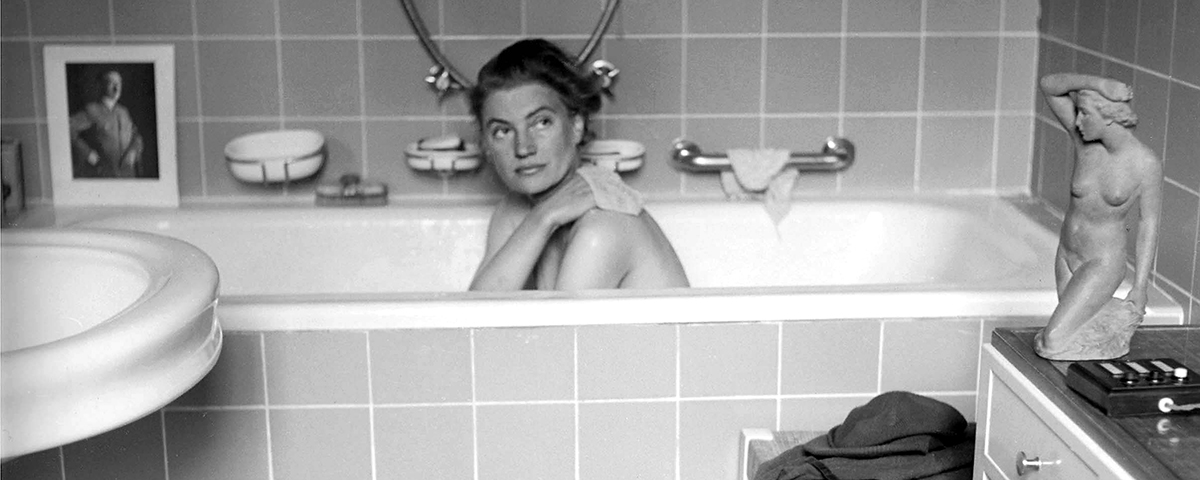World War II was ending in Europe, and American combat photographer Lee Miller wanted nothing more than to clean up. Miller, who was shooting for the Condé Nast magazine group, and fellow correspondent David E Scherman, with Life Magazine, had just come from hours documenting atrocities at an awful place called Dachau. Arriving in Munich, 13 miles southeast and in the throes of collapse, Miller and Scherman entered an apartment house at 16 Prinzregentenplatz. Adolf Hitler had maintained a residence at that address since the 1920s; in 1935 the dictator had bought the building, converting the sub-basement into a bomb shelter and the ground floor into quarters for bodyguards. The second floor was his private suite.
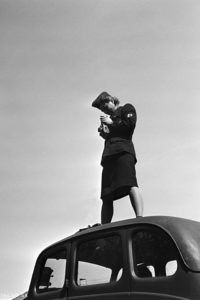
Miller and Scherman made themselves comfortable. Miller, 38, filled Hitler’s bathtub, peeled off her combat boots and fatigues, and slid into the hot water. Scherman—not only a colleague but Miller’s lover—framed a scene: the photographer bathing, in the foreground her muddy boots on a white bathmat and a kitschy replica Venus de Milo, on the tub edge a portrait of the Führer. After a while the two traded places, and Miller photographed Scherman bathing. Her picture ran in the July 1945 UK Vogue. His didn’t. “The place was filled with mediocre, dull art,” Miller said later. Soldiers of the U.S. Army 45th Division’s 179th Regiment commandeered the flat as their command post. The GIs and the correspondents were listening to the radio that evening when the BBC reported Hitler’s suicide. A few days later Miller and Scherman accompanied Allied troops to Hitler’s retreat in the Bavarian Alps. Vogue carried Miller’s images of the Berghof burning,
“Salvage,” England 1943 by David E. Scherman 5005-16 (Copyright Lee Miller Archives, England 2018)
torched by retreating SS. She recorded Germany in ruins, the aftermaths of Nazi bigwigs’ suicides, retaliatory beatings of death camp guards, and impromptu executions of former collaborators. Incongruously, amid the desolation she shot fashion images, as well.
The war’s end punctuated a vibrant career Miller built in front of and behind the lens, a three-decade arc that saw the stoic blonde beauty from Poughkeepsie, New York, live and disport across continents among famous artists and writers. In the process of acquiring as paramours, friends, and admirers Man Ray, Pablo Picasso, Edward Steichen, Jean Cocteau, René Magritte, Joan Miró, Max Ernst, and their female companions, Miller earned her keep as a leading magazine fashion model, photographer, and combat correspondent, as well as being, according to son Antony Penrose, a depressive alcoholic and a terrible mother.
Elizabeth Lee Miller began life under a cloud. Born April 23, 1907, in Poughkeepsie, she was seven when a family friend raped her, infecting the child with gonorrhea. Soon after, despite knowing his daughter’s emotional torment, her father Theodore, a mechanical engineer and amateur photographer, nonetheless enlisted Lee as a darkroom assistant and model, posing the child unclothed for “art studies” using a stereoscopic camera of the sort often associated with erotica and burlesque performers. The experience hardened the girl at a young age. “Lee had the attitude that the world had failed her,” said Antony Penrose. “The only person who was really going to take care of her was herself.” Trained by her dad in photographic and darkroom technique, Lee posed nude for him, often with girlfriends, well into her 20s.
A troubled student, Lee was expelled from nearly every school in the Hudson Valley. Seeing actress Sarah Bernhardt onstage in 1917 convinced the girl she wanted to act. In 1924, 17-year-old Lee persuaded her parents to send her to Paris to attend L’École Medgyès pour la Technique du Theatre. Chaperoned by her French teacher, she spent seven months studying lighting, costume, and theater design.
Back home, she enrolled at Vassar College and the Art Students League, in off hours frequenting bohemian Greenwich Village. After pulling her out of the way of a wayward truck, magazine magnate Condé Nast recruited Miller to pose for Vogue and Harper’s Bazaar. The March 1927 Vogue cover by illustrator Georges
Lepape showed Miller as a quintessential flapper in cloche, bob, and pearls, a metropolis shimmering behind. Miller joined the decade’s squad of It Girls, at times wearing her pale hair so androgynously short that homosexual lensman Cecil Beaton declared she looked “like a sun-kissed goat boy from the Appian Way.” Miller soon was posing for master photographers like Steichen, Nickolas Muray, and Arnold Genthe in sessions that turned into tutorials, as when Steichen shared tips on fashion photography and commercial portraiture. Miller also studied studio lighting with the masterful George Hoyningen-Huene.
Miller’s modeling career ran aground on a taboo in 1928 when menstrual pad maker Kotex licensed and published a Steichen image of her in a magazine ad, outraging bluenoses. Cut out of editorial modeling work, Miller decided to take up the camera. Carrying a letter of introduction from Steichen to Surrealist artist Man Ray, she returned to Paris in 1929. The Philadelphia-born expatriate’s Montparnasse studio was empty; Miller nosed around until she found him in a neighborhood bar and introduced herself as his next student.
“I don’t have students,” Ray replied. In bed and elsewhere, however, Miller persuaded him otherwise, and when, a few weeks later, Ray headed to Biarritz, she went along, the start of a three-year liaison in which Miller was assistant, muse, and paramour to Ray, born Emmanuel Raditsky. Ray, nearly twice Miller’s age, welcomed her into his iconoclastic world, peopled by unfettered spirits like him—and, it turned out, her. “She was made for it, and it for her,” Antony Penrose said. The pair delighted in happy accidents, like their rediscovery of “solarization,” in which a paper photographic print halfway through processing is exposed to a flash of light, producing a dramatic effect. Ray’s solarized nudes, which included several of Miller, are some of his best-known works.
Surrealists were intensely social, and along with hedonistic revels and high society balls in Paris, Ray and Miller joined a fizzy set fond of vacationing in the south of France with Pablo Picasso and photographer Dora Maar, his girlfriend. Miller felt deeply for Ray but insisted on her independence. In 1930, Jean Cocteau cast Miller in his film, The Blood of a Poet, coating the lissome American with butter and transforming her into a classical statue. Ray fumed. With Cocteau also in pursuit, Miller moved to New York City and opened Lee Miller Studio, billing her enterprise as “the American Brand of the Man Ray School of Photography.” The break-up seemed to energize Ray, prompting him to paint “Observatory Time,” an oil of Lee’s glowing lips flying over a forest, and “Object to Be Destroyed,” a metronome with Lee’s ticking eye that he smashed with a hammer. Ray’s rage dissipated. He married dancer Juliet Browner. In 1937, he and Miller reconciled, remaining close for life.
Lee Miller Studio, two blocks from St. Patrick’s Cathedral, developed a brisk trade with Vogue, Chanel, Saks Fifth Avenue, I. Magnin & Co., and other clients. Brother Erik Miller handled the darkroom while his sister focused on making images and exhibiting alongside photographers like Beaton, Margaret Bourke-White, and Edward Weston. Miller worked at portraiture, developing a reputation as one of New York’s face-making aces. But she also guarded her credibility as a serious avante-garde artist. Actor-director Charlie Chaplin, with whom she once traveled in France, called her his favorite Surrealist. The May 1934 edition of Vanity Fair listed Lee Miller and Cecil Beaton among the most distinguished living photographers of the first half of the 20th century.
Depleted by two successful, demanding years, Miller shuttered the studio and moved to Cairo. In France with Chaplin, she had met a rich Cairene, Aziz Eloui Bey. She looked him up, they connected, and married. Egypt at first fascinated her but soon palled. In 1936, she took her camera into the Western Desert. Near Siwa, a remote oasis town, she made a photograph she called “Portraits of Space,” a Surrealist exercise that inspired Belgian artist René Magritte to paint Le Baiser (“The Kiss”). Homesick for Paris, Miller asked her husband’s leave to summer in France. Her first night in Paris she attended a costume ball, where she met Roland Penrose, a wealthy English painter and curator familiar with Ray’s erotic images of her. Smitten, the two careened around Europe all summer with Man Ray, his new companion, Ady Fidelin, and other artists. Miller posed for Picasso, one of six paintings he did of her; she exposed more than 1,000 frames of him. With Penrose, Miller traveled to Cornwall, Greece, and Lebanon to photograph village life. Returning to Cairo and Bey, Miller maintained a liaison with the now-divorced Penrose.
Miller and Bey split in June 1939 but did not divorce. Lee took up residence with Penrose in London. When war began that September, the U.S. State Department advised citizens to head home. Miller ignored the guidance,
in July 1940 she sent two English children to live with her folks in Poughkeepsie. She joined British Vogue, covering fashion, lifestyle, and women in the military. Penrose went to work as an air raid warden and camouflage instructor, often traveling to his assignments. After Pearl Harbor, which Britons saw as a comeuppance for isolationist America, Miller began seeking out American journalists. At a party in the London offices of Life on Dean Street in Soho, Miller, 34, met wisecracking New Yorker David Scherman, 25. The charismatic photographer became a regular at the soirees Miller and Penrose threw and soon moved in with the couple. True to his aesthete’s code, Penrose let his companion know that when he was away Scherman was fair game for her.
Miller took him up on it. Scherman, who had apprenticed with Alfred Eisenstaedt and Bourke-White, mentored Miller on photojournalism. He urged her to apply for credentials to cover the war. She did, getting fatigues tailored on Savile Row. She photographed and wrote about women in uniform, society, and celebrities for Condé Nast Press. A month after D-Day, the Allied high command ruled that female correspondents could cover the war on the battlefields of France.
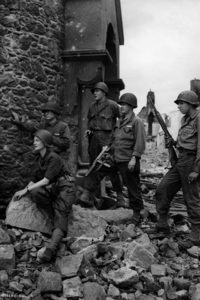
A war was just what Lee Miller needed. Everything she had learned in the past 15 years—from knowing how to move in front of a camera to where to place a camera to studying with master lensmen to traveling solo in exotic lands—came together. In July 1944 British Vogue sent Miller to Normandy to report on American nurses at the 44th Evacuation Hospital in La Cambe. She traveled with Scherman.
At La Cambe, surgical teams were performing 100 procedures every 24 hours; ultimately, of 500 patients there, only 50 lived. Miller noted the nurses’ and surgeons’ quiet focus amid the soundtrack of a nearby battle. A tent hospital reminded her of Hieronymus Bosch’s hellish oeuvre. A badly burned soldier, wrapped like a mummy with oven mitt hands and tiny slits for eyes, nose, and mouth, asked Miller to take his picture so he could see how funny he looked. “It was pretty grim, and I didn’t focus well,” she recalled of the photo, published in Vogue on both sides of the Atlantic
On August 13, Miller, ignoring regulations, went to St. Malo, a port in Brittany where the U.S. Army’s 83rd Infantry Division was attacking heavily fortified German positions, occasioning some of the worst fighting of the war. “She’d come back with incredible, first-rate combat photos,” recalled Scherman. Miller was the only female photographer to stay through the siege. She unknowingly recorded the first Allied use of napalm. Squeezing
the shutter, she watched as “bombs plummeted into the Citadel, swallowing it up in smoke.” Army censors confiscated her negatives and prints of the firebombing. During the final assault on the Citadel, she took shelter in a German dugout, stepping on a severed hand.
Miller’s courage and lack of pretense earned her the respect of the men she was covering. The former fashion plate was living on C-rations, bunking among—and, when the mood struck, with—the boys. Scherman described her as looking like “an unmade, unwashed bed.” By the time St. Malo fell, much of the city was in ruins. On August 25, Miller and Scherman arrived in Paris as Liberation Day celebrations were in high gear. They holed up with fellow correspondents at the Hotel Scribe. “It’s very bitter to me to go to Paris now that I have a taste for gun powder,” Miller wrote to her editor. While there she tracked down Picasso and Cocteau, as well as founding Surrealist Paul Éluard and his wife Nusch, emerging from hiding to avoid the Gestapo.
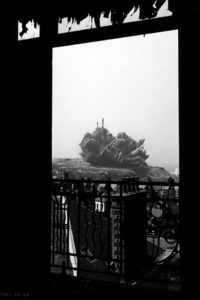
Miller’s next assignment was to help revive French Vogue, which the Vichy regime had shuttered in 1940. In September, at Beaugency in the Loire Valley, she covered the surrender by 20,000 Germans to 24 Americans from the Seventh Army, months later switching modes to photograph the first Paris fashion collections since the occupation. In November, Miller traveled to recently liberated Luxembourg and Brussels, looking for and finding her favorite Belgian painters, Magritte and Paul Delvaux, safe and in good health. She spent Christmas with Penrose and Scherman in London. At Paris in March she and other correspondents got permission to cover the Allied advance into Germany. At the border she photographed women harvesting dandelions for food in a bare potato field. In Aachen, which, she said, “smelled and looked like a sepulcher,” she encountered arrogant locals, well clad and well fed, feigning ignorance of Nazism. In Cologne, Miller roomed with Bourke-White and New York Herald Tribune reporter Marguerite Higgins. Asked by her editor to report in, Miller said German resistance was crumbling so briskly as to make it difficult to note her
location, adding that she was “wearing the same trousers I wore when I left Paris six weeks ago.”
On April 25, trudging among a stream of displaced persons along the Elbe River, she met a Russian. This coincidental connection landed her at Torgau, Germany, in time to document the epic meeting of GIs and Red Army soldiers.
Scherman arrived late, but he did show up in time to frame Miller flirting with Russian officers and holding a hammer-and-sickle flag while her companions posed with the Union Jack and the Stars and Stripes.
In Nuremberg, Life photographer Dick Pollard tipped Scherman and Miller, who already had covered the liberation of Buchenwald—the background of one of her photos there included a 16-year-old Elie Wiesel—to a report about Seventh Army heading to Dachau. The photographers arrived at the camp on April 29 amid a melee. The U.S. Army 42nd and 45th Infantry Divisions and 20th Armored, along with a gaggle of reporters, were vying to get in on the last big story of the war. Miller’s were some of the most shocking photographs of the camps, made up close, with no emotional distance to soften the impact. Vogue ran the horrors captioned simply “Believe It!”
Miller was writing when word came of the German capitulation. “Shit,” she said. “That’s blown my first paragraph!” She struggled with peace, missing the camaraderie of combat as she covered post-war Europe, barely communicating with Penrose in London. In Eastern Europe she covered the lives of peasants and aristocrats unmoored by history, risking all to lean out of a high window to grab a shot of the execution by firing squad of ex-premier of Hungary László Bárdossy. In Vienna, she watched malnourished babies die in a hospital. Vogue’s renewed fashion demands gave life a schizoid quality; she ping-ponged from documenting refugees to framing a
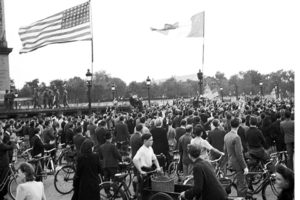
diva belting an aria from “Madame Butterfly” in the ruins of the Vienna Opera House. It took Penrose and Scherman until February 1946 to pry Miller, accreditation long since withdrawn, out of ruined Europe. In 1947, she divorced Bey and married Penrose, and at nearly 40 bore a son, Antony. Depression overtook her, as did drink. Her husband ran around. His writing and curatorial career took off, leading to a knighthood that made his wife Lady Penrose.
In 1949 the Penroses purchased Muddles Green, an 18th century farmhouse in Chiddingly, East Sussex, that became a constant garden party, attracting artists and writers. Artwork by friends remade the place into a Surrealist gallery. Miller’s final photo essay for Vogue in July 1953, “Working Guests,” featured notables performing chores. She pictured Alfred H. Barr Jr., director of New York City’s Museum of Modern Art, feeding pigs. Artist Max Ernst weeded flower beds. Pablo Picasso posed feeding cows with Antony while New Yorker cartoonist Saul Steinberg battled with a garden hose.
In 1960 Miller again transformed herself, this time into a proto-foodie, as cooking became her therapy and creative outlet. She studied cuisine in Paris and London, befriending such gustatory luminaries as James Beard. She amassed a library of 2,000 cookbooks and developed quirky recipes of her own with names to match: Blue Spaghetti, Muddles Green Green Chicken, Pink Cauliflower Breasts, Upside Down Onion Cake. She often served meals on china liberated from the Berghof and initialed “AH.” American Vogue described her cooking as “food painting.”
Miller downplayed her career, happy to let work stay in the shadows into which it had receded. “I only took a few pictures a long time ago,” she would say. She died of cancer in 1977. Antony, rummaging in the farmhouse attic, came upon a cache: 60,000 negatives, 20,000 prints and contact sheets—Miller had destroyed many of her concentration camp images—documents, and writings he archived and presents at leemiller.co.uk, attracting the attention of academics and the photographic cognoscenti. Exhibitions, monographs, and biographies of Lee Miller have followed. In 2017, granddaughter Ami Bouhassane published Lee Miller: A Life with Food Friends & Recipes.

